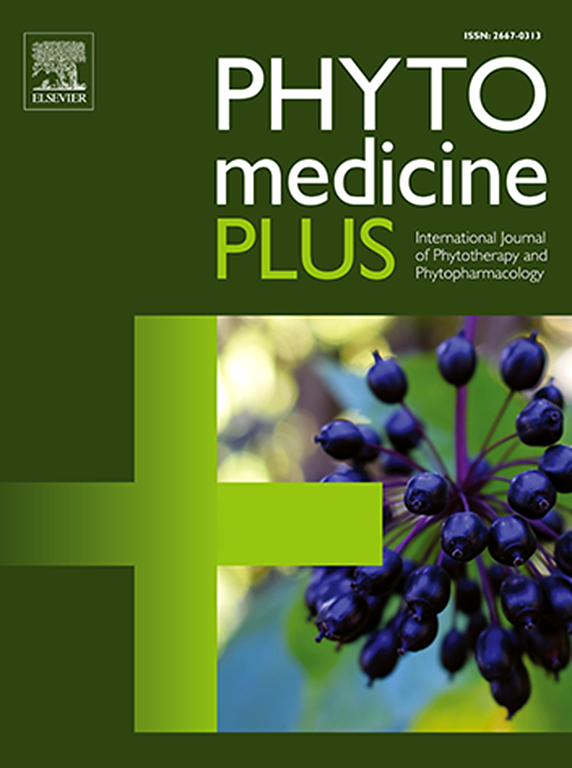针对高脂血症:极性驱动三元萃取荆顶草生物活性-体内、体外和计算机耦合研究
Q3 Pharmacology, Toxicology and Pharmaceutics
引用次数: 0
摘要
高血脂是动脉粥样硬化和冠心病(CHD)发生和发展的一个重要因素。虽然有许多药物可以调节我们身体的脂肪含量,但目前对天然产品的迷恋加速了从天然来源寻找降低胆固醇的新分子。在我们的研究中,Apium graveolens(芹菜)已证明优于对照药物。目的结合已有研究(96%乙醇),对溶剂体系(70%甲醇+ 30%丙酮)进行了改进。在96%的乙醇中,大部分疏水化合物可以溶解。然而,在我们的溶剂系统中,我们通过添加15%的水来增强极性,因此更多的亲水性化合物可以存在于提取物中。同时,15%的丙酮会产生高分子量的多酚。因此,在我们的提取物中会出现各种各样的化合物(亲水性、疏水性和高分子量多酚)。然而,在之前的研究中,研究使用了96%的乙醇,而我们使用了70%的甲醇,因此,我们会得到疏水化合物的浓度降低。因此,我们的目的是探讨亲水抗高脂血症和高分子量多酚是否可以补偿疏水抗高脂血症成分浓度的降低。材料与方法采用三元萃取溶剂制备荆芥提取物。在严密监测下,将95只健康的雄性Wister白化大鼠分为19组进行体内研究。采用荧光显微镜进行组织病理学观察,并对实验数据进行统计评估。结果和讨论根据实验数据,高脂血症大鼠在服用用三元萃取溶剂制备的石竹提取物后,其高密度脂蛋白、低密度脂蛋白、甘油三酯和总胆固醇水平显著恢复。此外,与疾病对照组相比,接受植物提取物治疗的大鼠血清中肝损伤生物标志物和肾功能生物标志物的水平显著降低。组织病理学研究表明,高剂量的石首草可改变与肝损伤相关的组织病理学标志物的状态。计算机研究结果表明,表现最好的3种化合物(apiumoside, apiin和graveobioside B)对选定的抗高脂血病靶标HMG CoA还原酶和过氧化物酶体增殖激活受体α (PPAR-Alpha)具有很高的结合亲和力,并且在针对选定靶标的分子动力学模拟中具有非常稳定的状态。结论由此推断,石竹可能含有一些有发展前景的亲水抗高血脂成分、抗氧化剂和一些高分子量多酚类物质。本文章由计算机程序翻译,如有差异,请以英文原文为准。

Targeting hyperlipidemia: A polarity-driven ternary extraction of Apium graveolens bioactives—A coupled in-vivo, in-vitro and in-silico investigation
Introduction
An important factor in the onset and progression of atherosclerosis and coronary heart disease (CHD) is hyperlipidemia. Though numerous medication classes are available to regulate our body's fat content, the current fascination with natural products has accelerated the hunt for novel molecules from natural sources that decrease cholesterol. In our investigations, Apium graveolens (celery) has demonstrated a superior effect than the control medications.
Objective
Considering previous research (96 % Ethanol), we modified the solvent system (70 % methanol and 30 % aqueous acetone). In 96 % ethanol, mostly the hydrophobic compound can be dissolved. However, in our solvent system we enhance the polarity by adding 15 % water so more hydrophilic compounds could be present in the extract. Also, 15 % acetone would draw high molecular weight polyphenols. As a result, a wide array of compounds (hydrophilic, hydrophobic, and high molecular weight polyphenols will be present in our extract. However, in a previous study, the research used 96 % ethanol and we are using 70 % methanol, as a result, we will get a diminished concentration of hydrophobic compound. So, we aim to explore whether the hydrophilic anti-hyperlipidemic and high molecular weight polyphenol can compensate for the reduced concentration of hydrophobic anti-hyperlipidemic constituents.
Materials and methods
The Apium graveolens extract was prepared using a ternary extraction solvent. Under careful monitoring, the in-vivo study was conducted by distributing 95 healthy Wister albino male rats into 19 groups. Histopathological investigation was conducted using fluorescence microscope, followed by statistical assessment of the experimental data.
Results and discussion
According to the experimental data, rats with disrupted hyperlipidemic conditions showed a significant restoration in their HDL, LDL, triglycerides, and total cholesterol levels upon administration of Apium graveolens extract prepared with the ternary extraction solvent. Moreover, rats treated with the plant extract exhibited a significant reduction in their serum levels of the hepatic damage biomarkers and renal function biomarkers compared to the disease control group. The histopathological investigations showed that Apium graveolens at high doses can change the status of histopathological markers associated with liver damage. The findings of the in-silico studies revealed that the 3 top performing compounds (i.e. apiumoside, apiin and graveobioside B) showed high binding affinity to selected anti hyperlipidemic targets HMG CoA reductase and peroxisome proliferator-activated receptor-Alpha (PPAR-Alpha) with a very stable condition in the molecular dynamic simulation against the selected targets.
Conclusion
Based on our findings it can be inferred that Apium graveolens may contain some promising hydrophilic anti-hyperlipidemic constituents, antioxidants and some high molecular weight polyphenols.
求助全文
通过发布文献求助,成功后即可免费获取论文全文。
去求助
来源期刊

Phytomedicine Plus
Medicine-Complementary and Alternative Medicine
CiteScore
3.70
自引率
0.00%
发文量
178
审稿时长
81 days
期刊介绍:
 求助内容:
求助内容: 应助结果提醒方式:
应助结果提醒方式:


